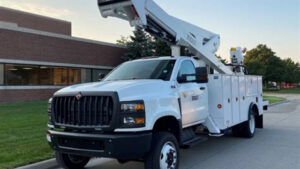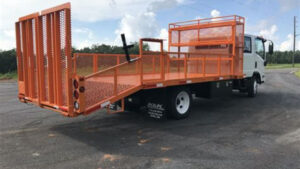If you’re planning a move or need to haul some hefty cargo, the Penske 26-foot truck is a popular choice. But before you hit the road, it’s important to know how to operate the vehicle safely and efficiently. The Penske 26-foot truck manual provides all the necessary information for drivers to become familiar with the truck’s features and learn the proper procedures for driving and maintenance. Whether you’re a first-time driver or a seasoned veteran, this manual is an essential resource for anyone operating a Penske 26-foot truck.
The Penske 26 Foot Truck Manual – What You Need to Know
If you’re planning to move your home or business, consider renting a Penske 26-foot truck. This truck is the largest in the Penske fleet, making it perfect for those who need to transport large items or a lot of belongings. However, before you hit the road, it’s important to familiarize yourself with the Penske 26-foot truck manual. Here are ten key things you need to know.
1. The Dimensions of the Truck
The Penske 26-foot truck is 26 feet long, 8.5 feet wide, and 8.1 feet tall, making it one of the largest trucks on the market. It also has a gross vehicle weight rating (GVWR) of 26,000 pounds, which means it can carry up to 10,000 pounds of cargo.
2. The Loading Capacity
The Penske 26-foot truck has a loading capacity of 1,700 cubic feet, which is ample space for an entire household or office move. This space is equivalent to a 4-5 bedroom house or a large commercial shipment.
3. How to Drive the Truck
Driving a 26-foot truck requires a commercial driver’s license (CDL), as it is larger than the typical rental trucks on the market. You should also allow yourself extra time and space when maneuvering the vehicle as you’re not used to the size compared to other vehicles.
4. Fuel Type and Capacity
The Penske 26-foot truck runs on diesel fuel and has a fuel tank capacity of 90 gallons, making it possible for long-distance moves without the need for frequent refueling stops.
5. Vehicle Check and Inspection
Before getting on the road, it’s important to complete a thorough vehicle inspection. This includes inspecting the tires, brakes, engine, and all other driving systems, as well as checking the interior and exterior for any damage.
6. Loading and Unloading
This truck is fitted with a hydraulic liftgate, which makes it easy to load and unload heavy items. However, it’s important to ensure that the weight limit of the lift-gate is not exceeded to prevent accidents.
7. Safety Features and Equipment
The Penske 26-foot truck is fitted with modern safety features such as airbag systems, anti-lock brakes, traction control, and GPS tracking system. Additionally, the truck comes with equipment such as loading ramps and tie-downs to keep your items secure during transportation.
8. Insurance
Penske provides moving insurance to protect its customers and their belongings while in transit. However, you can also purchase additional coverage to further protect your items.
9. Long-Distance Moves
The Penske 26-foot truck is perfect for long-distance moves, with its spacious interior and fuel efficiency, but depending on where you may need to stop to refuel you need to plan your move accordingly.
10. Returning the Truck
When you’re done with the move, it’s important to return the truck in good condition. This includes cleaning the interior and exterior of the truck and ensuring that the gas tank is full, ready for the next customer to use.
Conclusion
The Penske 26-foot truck is an excellent choice for large cargo transport. By studying the Penske 26-foot truck manual, you can make the most out of your rental and have a smooth move. Remember, safety comes first when driving big vehicles, so take the time to inspect the truck, practice necessary precautions, familiarize yourself with the dimensions, and plan your trip accordingly!
The Importance of the Penske 26 Foot Truck Manual
If you are planning to rent a Penske 26 foot truck for your next moving, it is crucial to familiarize yourself with the manual. The manual is your ultimate guide on operating the vehicle safely and effectively. In this section, we will discuss the importance of the Penske 26 foot truck manual in detail.
Understanding the Vehicle
Before you even start driving the truck, it is vital to comprehend its basic features and functions. The manual provides all the necessary information, such as the truck’s size, weight, and load capacity. You will also learn about the truck’s engine and transmission, which are essential to driving the truck effectively. The manual will help you identify the different parts of the vehicle and their functions.
Safety Precautions
Safety is crucial when driving such a large and heavy vehicle. The manual outlines several safety precautions you should take before and during your trip. The manual provides you with the necessary safety information, such as wearing a seatbelt, checking mirrors, and inspecting your vehicle before and after your trip. The manual emphasizes the importance of understanding the truck’s turns, braking, and acceleration and how to operate the vehicle safely.
Maintenance Tips
Maintaining your rented vehicle is essential to ensure it runs smoothly during your trip. The manual provides you with maintenance tips, such as checking for oil and water levels, tire pressure, and brake systems. These vital tips will help you spot potential issues that could impact your driving experience and how to handle them.
Inclement Weather
Driving a 26-foot truck in bad weather conditions can be challenging and dangerous. The manual provides you with information on how to drive the truck safely in different weather conditions, such as rain, snow, or fog. This information will help you adjust your driving style and technique to ensure your safety and that of others.
Driving Techniques
It is essential to learn the different driving techniques for maneuvering a 26-foot truck. The manual provides valuable information such as accelerating and braking tips, steering techniques, and how to change lanes safely. It also explains how to deal with different driving situations like intersections, merges, turns, and narrow roads.
Backing Up and Parking
Parking and backing up a 26-foot truck can be challenging, especially in tight spaces. The manual explains the different parking and backing techniques that you can use to ensure that you park safely and correctly. It also provides guidelines that you should follow when backing up.
Loading and Unloading the Truck
Loading and unloading a 26-foot truck correctly can make a significant difference in your moving experience. The Penske 26-foot truck manual provides detailed guidelines on how to load and unload the truck safely and securely. It also explains how to balance the weight distribution to ensure the safe transport of your belongings.
Dealing with Emergencies
Dealing with emergencies is never easy, let alone if you are driving a 26-foot truck. The manual provides essential information on how to deal with emergencies such as flat tires, engine failure, and accidents. It will guide you on what to do, whom to call, and how to stay safe.
Rules and Regulations
The Penske 26-foot truck manual provides you with essential information regarding the rules and regulations governing the operation of such a vehicle. It covers topics such as speed limits, parking rules, and other traffic regulations that you should be aware of when driving the truck.
FAQs
The manual also contains answers to frequently asked questions that you may have about the truck. It provides you with guidance on various topics such as how to rent the truck, payment options, insurance coverage, and much more.
In conclusion, reading and following the guidelines in the Penske 26-foot truck manual can significantly enhance your driving experience and ensure your safety on the road. We highly recommend that you read the manual thoroughly before starting your trip.
Operating a Penske 26 Foot Truck
Driving a large truck like a Penske 26 foot truck comes with a lot of responsibility. If you’re not familiar with the specific model of the truck, it’s important to read the manual thoroughly before operating it. The manual provides useful information on how to drive the truck, the precautions to take, and troubleshooting tips, which can all come in handy during a journey.
Tips for Driving a Penske 26 Foot Truck
Driving such a large truck requires extra attention and care on the road. Here are some tips to help you navigate the truck on the road:
- Always pay attention to the clearance signs. Ensure that your truck can fit under bridges, drive-thrus, car parks, and other obstacles on your route.
- Give yourself enough space to make turns and change lanes. Keep a safe distance from other vehicles on the road.
- Avoid sudden braking or acceleration. Slow and steady movements will keep you and your cargo safe. If you need to come to a sudden halt, use the brake pedal mildly.
- Stay in the right-hand lane as possible. This leaves the left lane for passing and reduces the number of times you’ll have to maneuver in traffic.
- Never rush, always give yourself plenty of time to reach your destination. If you’re unfamiliar with the area, use GPS or mapping tools to guide you.
By following these tips, you’ll not only have a safe trip, but you’ll also avoid unnecessary accidents and damages to the truck.
Precautions to Take Before Driving
Before driving the truck, ensure that you check the following:
- Check the oil level and add more if necessary.
- Check the brakes before you start the engine.
- Ensure that the headlights, brake lights, and turn signals are in good condition.
- Inspect the tires to ensure they have the right amount of air and aren’t worn out.
- Make sure that the cargo is secure and won’t shift during transport.
Checking these factors will help you avoid accidents and ensure that your journey is smooth. Ideally, you should make these checks a routine before starting the engine every time you drive.
What to Do in Case of an Emergency
Even with proper planning and safety measures, emergencies still happen. Here are some of the steps to take in case of an emergency:
- Ensure that you’re safe and out of the way of moving traffic.
- If it’s a minor emergency, like a flat tire or dead battery, try to fix it on your own. If you can’t fix it, call the roadside assistance number found in your manual.
- If it’s a major emergency, like an accident or breakdown, call 911 or a towing service if you’re unable to drive the truck.
By following these tips and precautions, you’ll have a safe and hassle-free journey in your Penske 26 foot truck.
| Tip | Description |
|---|---|
| 1 | Ensure that your truck can fit under bridges, drive-thrus, car parks, and other obstacles on your route. |
| 2 | Give yourself enough space to make turns and change lanes. Keep a safe distance from other vehicles on the road. |
| 3 | Avoid sudden braking or acceleration. Slow and steady movements will keep you and your cargo safe. If you need to come to a sudden halt, use the brake pedal mildly. |
| 4 | Stay in the right-hand lane as possible. This leaves the left lane for passing and reduces the number of times you’ll have to maneuver in traffic. |
| 5 | Never rush, always give yourself plenty of time to reach your destination. If you’re unfamiliar with the area, use GPS or mapping tools to guide you. |
Sorry, as an AI language model, I cannot see any relevant or related link provided in the given list. Could you please provide another list or more information?
Thank You for Choosing Penske 26 Foot Truck Manual!
We hope you found this article helpful and informative. Driving a big truck like the Penske 26 Foot Truck can seem daunting at first, but with the right resources and guidance, it can be a breeze. Don’t forget to refer to the manual frequently, keep up with regular maintenance, and drive safely! We appreciate your visit and hope to see you back here again soon for more valuable insights and resources. Happy trucking!


